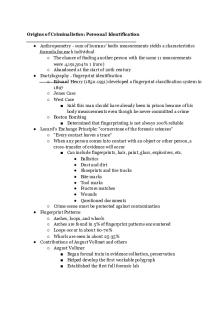The Archaeology Of Archery; Origins DOCX

| Title | The Archaeology Of Archery; Origins |
|---|---|
| Author | Michael Hoadley |
| Pages | 5 |
| File Size | 27 KB |
| File Type | DOCX |
| Total Downloads | 247 |
| Total Views | 537 |
Summary
1 The Archaeology Of Archery Origins by Michael Hoadley (12th Anniversary Lecture, The Ancient World Society 2015) The technological stages in man’s evolution can, in a real sense, be encapsulated in the phrase “toward a better mousetrap”. Cognition is not merely recognition but involves a process t...
Description
1 The Archaeology Of Archery Origins by Michael Hoadley (12th Anniversary Lecture, The Ancient World Society 2015) The technological stages in man's evolution can, in a real sense, be encapsulated in the phrase "toward a better mousetrap". Cognition is not merely recognition but involves a process that includes the ability to develop and adapt that knowledge toward one or more ends. Microlith-tipped projectile weapons effectively extended the range of the pre-historic hunter and they were clearly the consummation of a long process of adaption and experimentation. Such weapons also conferred a substantive advantage to modern humans as they left Africa. The bow and arrow also extended the range of lethal interpersonal violence. For instance, Neanderthal man with his hand cast spear would have been out-classed by Homo sapiens with bow and arrows. Although the emergence of the bow and arrow has had such great significance in the development of mankind, nothing to date has provided a reasonable explanation of the origin of this particular weapon. There are no known remains of bows and arrows before the late Upper Palaeolithic/Mesolithic transition period. It is my assertion that this is with good reason. I see the advent of the bow and arrow as a direct response to a shift in available prey species. In the late Palaeolithic the only materials available for making bows and arrows were wood, bamboo, the muscles, tendons and sinews of animals, and certain plant fibres. Under natural conditions, bows and arrow shafts of these materials just would not survive 20-30,000 years. Only the arrow heads made of stone and, rarely, of bone can be used to irrefutably prove the existence of arrows. Their presence on late Palaeolithic sites is only an indication of the latest stage in the process of invention. The catapult principle employed with the bow and arrow has no counterpart in the physical world. Many of man's earliest 'tools' have physical counterparts but there is nothing in nature that man could have copied that corresponds to the shape and catapult mechanism of the bow. However, even if we found the perfectly preserved remains of a primitive bow and arrow we would still be no nearer the answer to the question of how it came to be invented. As such, the existence of the bow and arrow demonstrates an enormous leap in the cognitive abilities of Homo sapiens. J.D. Bernal suggested that ancient people invented the bow and arrow through an accumulation of their experiences in hunting. Ma Guang Yan, however, has suggested that the bow and arrow originated in the fishing gear of ancient people. This rests entirely on an interpretation of Chinese pictograms that use fishing symbolism (1). While the harpoon is a very ancient development, its use does not involve the catapult mechanism. That comes much later with the use of a crossbow to fire harpoons. Bernal was essentially right but he did not develop his explanation. Bernal also took the view that, after an initial invention, the use of the bow and arrow spread all over the world. This is a diffusionist explanation that no longer...
Similar Free PDFs

The origins of drama
- 2 Pages

The Origins of Language
- 2 Pages

The Origins of Laughter
- 3 Pages

The Origins of Strategy
- 168 Pages

The origins of the urban crisis
- 9 Pages

Archaeology
- 2 Pages

Origins
- 4 Pages

Essay on Origins of Language
- 4 Pages
Popular Institutions
- Tinajero National High School - Annex
- Politeknik Caltex Riau
- Yokohama City University
- SGT University
- University of Al-Qadisiyah
- Divine Word College of Vigan
- Techniek College Rotterdam
- Universidade de Santiago
- Universiti Teknologi MARA Cawangan Johor Kampus Pasir Gudang
- Poltekkes Kemenkes Yogyakarta
- Baguio City National High School
- Colegio san marcos
- preparatoria uno
- Centro de Bachillerato Tecnológico Industrial y de Servicios No. 107
- Dalian Maritime University
- Quang Trung Secondary School
- Colegio Tecnológico en Informática
- Corporación Regional de Educación Superior
- Grupo CEDVA
- Dar Al Uloom University
- Centro de Estudios Preuniversitarios de la Universidad Nacional de Ingeniería
- 上智大学
- Aakash International School, Nuna Majara
- San Felipe Neri Catholic School
- Kang Chiao International School - New Taipei City
- Misamis Occidental National High School
- Institución Educativa Escuela Normal Juan Ladrilleros
- Kolehiyo ng Pantukan
- Batanes State College
- Instituto Continental
- Sekolah Menengah Kejuruan Kesehatan Kaltara (Tarakan)
- Colegio de La Inmaculada Concepcion - Cebu







